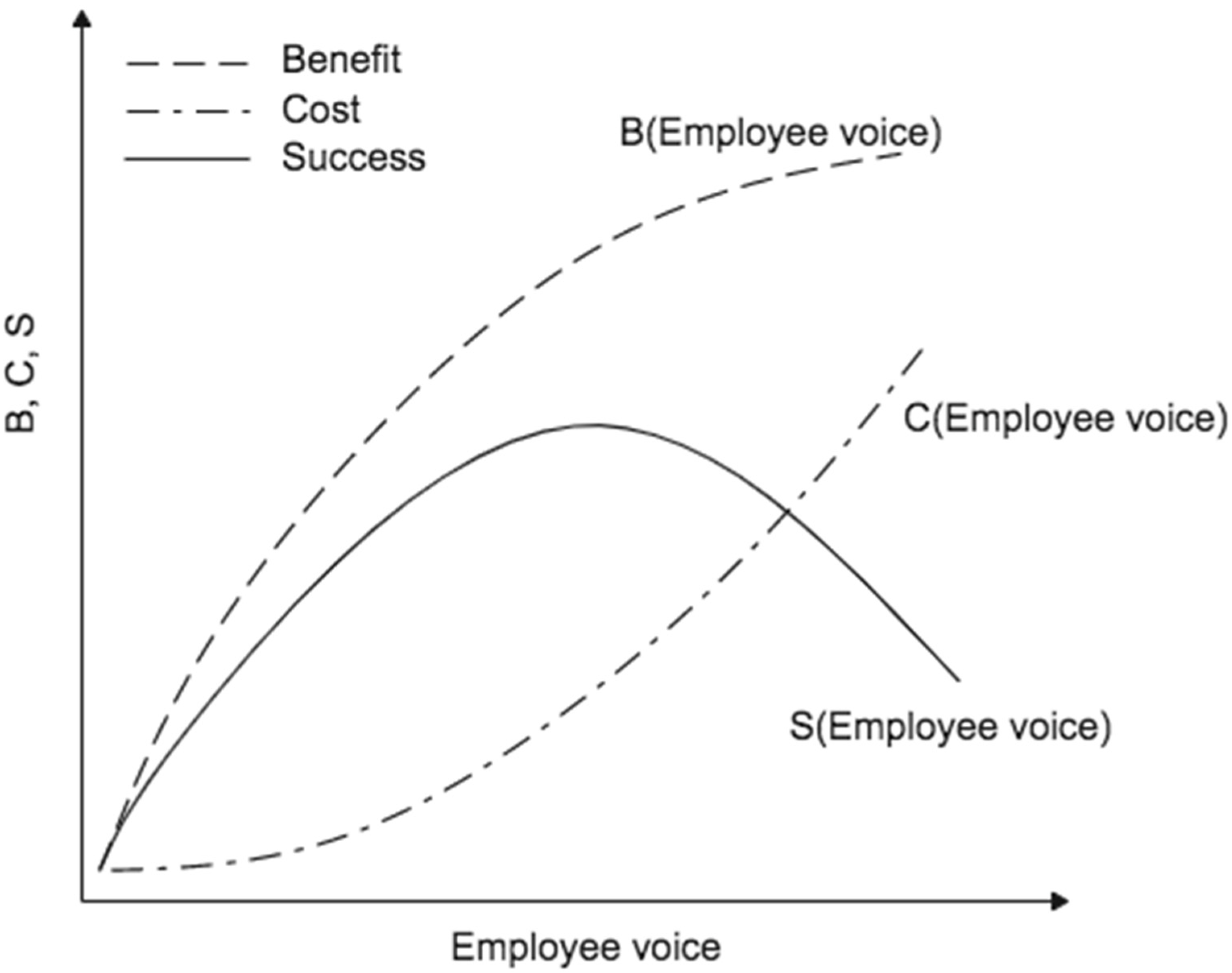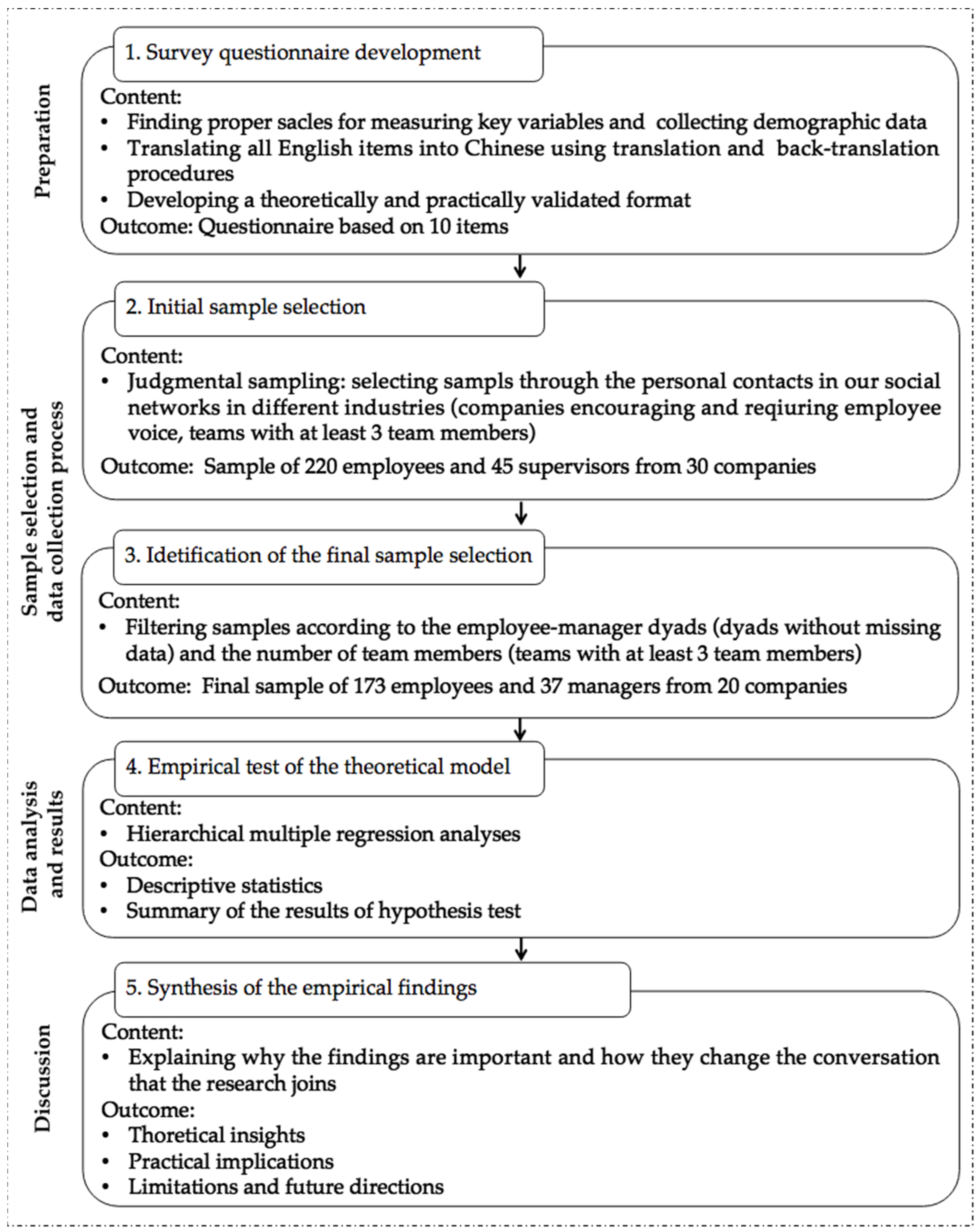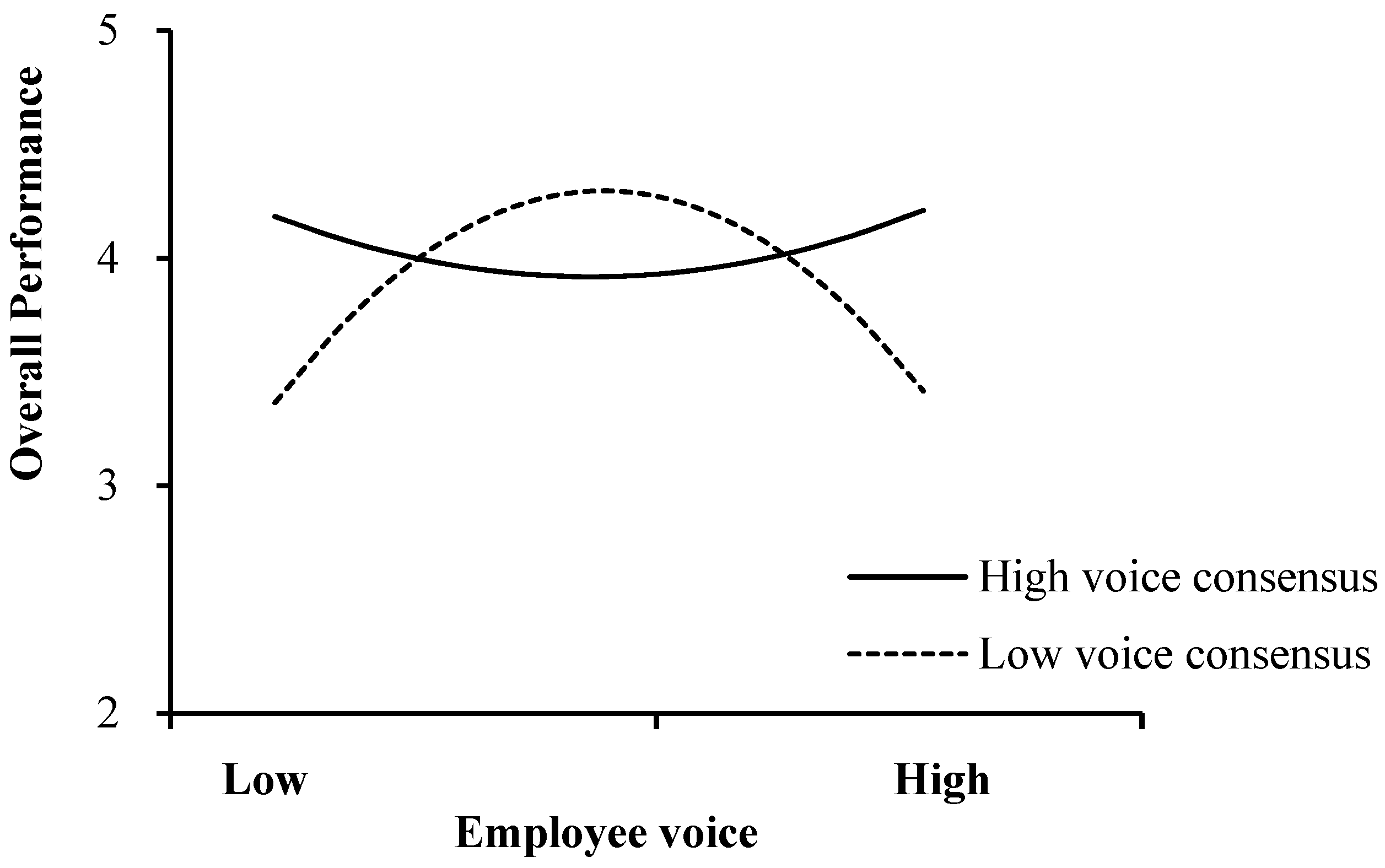The Curvilinear Relationship between Employee Voice and Managers’ Performance Evaluations: The Moderating Role of Voice Consensus
Abstract
:1. Introduction
2. Theory and Hypotheses
2.1. Voice Consensus
2.2. The ABC Framework
2.3. The Inverted U-Shaped Relationship between Employee Voice and Overall Performance
2.4. The Moderating Role of Voice Consensus
3. Method
3.1. Sample Selection
3.2. Procedures
3.3. Measures
3.3.1. Employee Voice
3.3.2. Voice Consensus
3.3.3. Overall Performance
3.3.4. Control Variables
3.4. Data Analysis
4. Results
5. Discussion
5.1. Theoretical Implications
5.2. Practical Implications
5.3. Limitations and Future Directions
6. Conclusions
Author Contributions
Funding
Institutional Review Board Statement
Informed Consent Statement
Data Availability Statement
Conflicts of Interest
References
- Spreitzer, G.; Porath, C.L.; Gibson, C.B. Toward human sustainability: How to enable more thriving at work. Organ. Dyn. 2012, 41, 155–162. [Google Scholar] [CrossRef]
- Hart, S.L.; Milstein, M.B. Creating sustainable value. Acad. Manag. Exec. 2003, 17, 56–67. [Google Scholar] [CrossRef]
- Van Dyne, L.; LePine, J.A. Helping and voice extra-role behaviors: Evidence of construct and predictive validity. Acad. Manag. J. 1998, 41, 108–119. [Google Scholar] [CrossRef]
- Sherf, E.N.; Tangirala, S.; Venkataramani, V. Why managers do not seek voice from employees: The importance of managers’ personal control and long-term orientation. Organ. Sci. 2019, 30, 447–466. [Google Scholar] [CrossRef]
- Li, A.N.; Liao, H.; Tangirala, S.; Firth, B.M. The content of the message matters: The differential effects of promotive and prohibitive team voice on team productivity and safety performance gains. J. Appl. Psychol. 2017, 102, 1259–1270. [Google Scholar] [CrossRef]
- Liang, J.; Shu, R.; Farh, C.I.C. Differential implications of team member promotive and prohibitive voice on innovation performance in research and development project teams: A dialectic perspective. J. Organ. Behav. 2019, 40, 91–104. [Google Scholar] [CrossRef]
- Weiss, M.; Zacher, H. Why and when does voice lead to increased job engagement? The role of perceived voice appreciation and emotional stability. J. Vocat. Behav. 2022, 132, 103662. [Google Scholar] [CrossRef]
- Kim, W.; Khan, G.F.; Wood, J.; Mahmood, M.T. Employee engagement for sustainable organizations: Keyword analysis using social network analysis and burst detection approach. Sustainability 2016, 8, 631. [Google Scholar] [CrossRef]
- Sutcliffe, K.M.; Vogus, T.J. Organizing for resilience. In Positive Organizational Scholarship; Cameron, K., Dutton, J.E., Quinn, R.E., Eds.; Berrett-Koehler: San Francisco, CA, USA, 2003; pp. 94–110. [Google Scholar]
- Paolillo, A.; Sinval, J.; Silva, S.A.; Scuderi, V.E. The relationship between inclusion climate and voice behaviors beyond social exchange obligation: The role of psychological needs satisfaction. Sustainability 2021, 13, 10252. [Google Scholar] [CrossRef]
- Silla, I.; Gracia, F.J.; Peiró, J.M. Upward voice: Participative decision making, trust in leadership and safety climate matter. Sustainability 2020, 12, 3672. [Google Scholar] [CrossRef]
- Bashshur, M.R.; Oc, B. When voice matters: A multilevel review of the impact of voice in organizations. J. Manag. 2015, 41, 1530–1554. [Google Scholar] [CrossRef]
- King, D.D.; Ryan, A.M.; Van Dyne, L. Voice resilience: Fostering future voice after non-endorsement of suggestions. J. Occup. Organ. Psychol. 2019, 92, 535–565. [Google Scholar] [CrossRef]
- Lee, W.R.; Choi, S.B.; Kang, S.-W. How leaders’ positive feedback influences employees’ innovative behavior: The mediating role of voice behavior and job autonomy. Sustainability 2021, 13, 1901. [Google Scholar] [CrossRef]
- Burris, E.R.; Detert, J.R.; Romney, A.C. Speaking up vs. Being heard: The disagreement around and outcomes of employee voice. Organ. Sci. 2013, 24, 22–38. [Google Scholar] [CrossRef]
- Howell, T.M.; Harrison, D.A.; Burris, E.R.; Detert, J.R. Who gets credit for input? Demographic and structural status cues in voice recognition. J. Appl. Psychol. 2015, 100, 1765–1784. [Google Scholar] [CrossRef]
- Huang, X.; Xu, E.; Huang, L.; Liu, W. Nonlinear consequences of promotive and prohibitive voice for managers’ responses: The roles of voice frequency and lmx. J. Appl. Psychol. 2018, 103, 1101–1120. [Google Scholar] [CrossRef] [PubMed]
- Whiting, S.W.; Podsakoff, P.M.; Pierce, J.R. Effects of task performance, helping, voice, and organizational loyalty on performance appraisal ratings. J. Appl. Psychol. 2008, 93, 125–139. [Google Scholar] [CrossRef] [PubMed]
- Chamberlin, M.; Newton, D.W.; Lepine, J.A. A meta-analysis of voice and its promotive and prohibitive forms: Identification of key associations, distinctions, and future research directions. Pers. Psychol. 2017, 70, 11–71. [Google Scholar] [CrossRef]
- Seibert, S.E.; Kraimer, M.L.; Crant, J.M. What do proactive people do? A longitudinal model linking proactive personality and career success. Pers. Psychol. 2001, 54, 845–874. [Google Scholar] [CrossRef]
- Busse, C.; Mahlendorf, M.D.; Bode, C. The abc for studying the too-much-of-a-good-thing effect: A competitive mediation framework linking antecedents, benefits, and costs. Organ. Res. Methods 2016, 19, 131–153. [Google Scholar] [CrossRef]
- Castaneda, D.I.; Ramírez, C.A. Cultural values and knowledge sharing in the context of sustainable organizations. Sustainability 2021, 13, 7819. [Google Scholar] [CrossRef]
- Burris, E.R. The risks and rewards of speaking up: Managerial responses to employee voice. Acad. Manag. J. 2012, 55, 851–875. [Google Scholar] [CrossRef]
- Markman, K.D.; McMullen, M.N. A reflection and evaluation model of comparative thinking. Pers. Soc. Psychol. Rev. 2003, 7, 244–267. [Google Scholar] [CrossRef] [PubMed]
- Lam, C.F.; Mayer, D.M. When do employees speak up for their customers? A model of voice in a customer service context. Pers. Psychol. 2014, 67, 637–666. [Google Scholar] [CrossRef]
- Liu, W.; Tangirala, S.; Lee, C.; Parker, S.K. New directions for exploring the consequences of proactive behaviors: Introduction to the special issue. J. Organ. Behav. 2019, 40, 1–4. [Google Scholar] [CrossRef]
- Kelley, H.H. Attribution theory in social psychology. In Nebraska Symposium on Motivation; Levine, D., Ed.; University of Nebraska Press: Lincoln, NV, USA, 1967; Volume 15, pp. 192–238. [Google Scholar]
- Alavi, M.; Leidner, D.E. Review: Knowledge Management and Knowledge Management Systems: Conceptual Foundations and Research Issues. MIS Q. 2001, 25, 107–110. [Google Scholar] [CrossRef]
- Morrison, E.W. Employee voice behavior: Integration and directions for future research. Acad. Manag. Ann. 2011, 5, 373–412. [Google Scholar] [CrossRef]
- Morrison, E.W.; Milliken, F.J. Organizational silence: A barrier to change and development in a pluralistic world. Acad. Manag. Rev. 2000, 25, 706–725. [Google Scholar] [CrossRef]
- Fast, N.J.; Burris, E.R.; Bartel, C.A. Managing to stay in the dark: Managerial self-efficacy, ego defensiveness, and the aversion to employee voice. Acad. Manag. J. 2014, 57, 1013–1034. [Google Scholar] [CrossRef]
- Griffin, M.A.; Neal, A.; Parker, S.K. A new model of work role performance positive behavior in uncertain and interdependent contexts. Acad. Manag. J. 2007, 50, 327–347. [Google Scholar] [CrossRef]
- Kelley, H.H.; Michela, J.L. Attribution theory and research. Annu. Rev. Psychol. 1980, 31, 457–501. [Google Scholar] [CrossRef]
- Frazier, M.L.; Fainshmidt, S. Voice climate, work outcomes, and the mediating role of psychological empowerment. Group Organ. Manag. 2012, 37, 691–715. [Google Scholar] [CrossRef]
- Dutton, J.E.; Ashford, S.J. Selling issues to top management. Acad. Manag. Rev. 1993, 18, 397–428. [Google Scholar] [CrossRef]
- Hristov, I.; Cimini, R.; Cristofaro, M. Assessing stakeholders’ perception influence on companies’ profitability: Evidence from Italian companies. Prod. Plan. Control, 2022; 1–15, ahead-of-print. [Google Scholar] [CrossRef]
- Lovallo, D.; Brown, A.L.; Teece, D.J.; Bardolet, D. Resource re-allocation capabilities in internal capital markets: The value of overcoming inertia. Strateg. Manag. J. 2020, 41, 1365–1380. [Google Scholar] [CrossRef]
- Zenger, T.R.; Lawrence, B.S. Organizational demography: The differential effects of age and tenure. Acad. Manag. J. 1989, 32, 353–376. [Google Scholar] [CrossRef]
- MacKenzie, S.B.; Podsakoff, P.M.; Fetter, R. Organizational citizenship behavior and objective productivity as determinants of managerial evaluations of salespersons’ performance. Organ. Behav. Hum. Decis. Process 1991, 50, 123–150. [Google Scholar] [CrossRef]
- Xu, E.; Huang, X.; Ouyang, K.; Liu, W.; Hu, S. Tactics of speaking up: The roles of issue importance, perceived managerial openness, and managers’ positive mood. Hum. Resour. Manag. 2020, 59, 255–269. [Google Scholar] [CrossRef]
- Aiken, L.S.; West, S.G. Multiple Regression: Testing and Interpreting Interactions; Sage: Newbury Park, CA, USA, 1991. [Google Scholar]
- Li, J.; Zajac, Z.E.J. Control, collaboration, and productivity in international joint ventures: Theory and evidence. Strateg. Manag. J. 2010, 30, 865–884. [Google Scholar] [CrossRef]
- Haans, R.; Pieters, C.; He, Z.L. Thinking about U: Theorizing and testing U- And inverted U-shaped relationships in strategy research. Strateg. Manag. J. 2015, 37, 1177–1195. [Google Scholar] [CrossRef]
- Lind, J.T.; Mehlum, H. With or without U? The appropriate test for a U-shaped relationship. Oxf. Bull. Econ. Stat. 2010, 72, 109–118. [Google Scholar] [CrossRef]
- Garvare, R.; Johannsson, P. Management for sustainability—A stakeholder theory. Total Qual. Manag. Bus. Excell. 2010, 21, 737–744. [Google Scholar] [CrossRef]
- Grant, A.M.; Ashford, S.J. The dynamics of proactivity at work. Res. Organ. Behav. 2008, 28, 3–34. [Google Scholar] [CrossRef]
- Ng, T.W.H.; Wang, M.; Hsu, D.Y.; Su, C. Voice quality and ostracism. J. Manag. 2020, 48, 281–318. [Google Scholar] [CrossRef]
- Briñol, P.; Petty, R.E. Source factors in persuasion: A self-validation approach. Eur. Rev. Soc. Psychol. 2009, 20, 49–96. [Google Scholar] [CrossRef]





| Variables | Mean | SD | 1 | 2 | 3 | 4 | 5 | 6 |
|---|---|---|---|---|---|---|---|---|
| 1. Age a | 3.35 | 0.86 | ||||||
| 2. Gender b | 0.23 | 0.42 | 0.00 | |||||
| 3. Dyadic tenure | 6.00 | 4.94 | 0.22 ** | −0.08 | ||||
| 4. Employee voice | 3.90 | 0.55 | −0.12 | −0.04 | −0.13 † | (0.61) | ||
| 5. Voice consensus | 0.67 | 0.30 | 0.03 | −0.07 | −0.07 | −0.18 * | ||
| 6. Overall performance | 3.96 | 0.78 | −0.06 | −0.08 | 0.12 | −0.02 | −0.05 | (0.84) |
| Variables | Overall Performance | |||||
|---|---|---|---|---|---|---|
| Model 1 | Model 2 | Model 3 | Model 4 | Model 5 | Model 6 | |
| Intercept | 4.13 *** (0.24) | 4.26 *** (0.52) | 4.62 *** (0.53) | 4.45 *** (0.56) | 4.47 *** (0.61) | 4.10 *** (0.61) |
| Age a | −0.08 (0.07) | −0.08 (0.07) | −0.07 (0.07) | −0.07 (0.07) | −0.07 (0.07) | −0.07 (0.07) |
| Gender b | −0.13 (0.14) | −0.13 (0.14) | −0.13 (0.14) | −0.12 (0.14) | −0.12 (0.14) | −0.14 (0.14) |
| Dyadic tenure | 0.02 (0.01) | 0.02 (0.01) | 0.02 (0.01) | 0.02 (0.01) | 0.02 (0.01) | 0.02 (0.01) |
| Employee voice | −0.03 (0.11) | −0.09 (0.11) | −0.09 (0.11) | −0.09 (0.13) | −0.07 (0.12) | |
| Employee voice2 | −0.41 * (0.15) | −0.50 * (0.18) | −0.50 * (0.19) | −0.18 (0.23) | ||
| Voice consensus | 0.23 (0.24) | 0.23 (0.24) | 0.58 * (0.28) | |||
| Employee voice × voice consensus | 0.02 (0.32) | −0.51 * (0.38) | ||||
| Employee voice2 × voice consensus | −1.12 * (0.44) | |||||
| R2 | 0.03 | 0.03 | 0.07 | 0.07 | 0.07 | 0.11 |
| ΔR2 | 0.03 | 0.00 | 0.04 | 0.01 | 0.00 | 0.04 |
| ΔF | 1.59 | 0.07 | 7.20 * | 0.89 | 0.01 | 6.52 * |
| Moderator | β | ||||
|---|---|---|---|---|---|
| X (2SD Low) | X (1SD Low) | X (Medium) | X (1SD High) | X (2SD High) | |
| High voice consensus | −0.26 | −0.09 | 0.08 | 0.26 | 0.43 |
| Low voice consensus | 0.90 * | 0.34 | −0.22 | −0.78 ** | −1.34 ** |
Publisher’s Note: MDPI stays neutral with regard to jurisdictional claims in published maps and institutional affiliations. |
© 2022 by the authors. Licensee MDPI, Basel, Switzerland. This article is an open access article distributed under the terms and conditions of the Creative Commons Attribution (CC BY) license (https://creativecommons.org/licenses/by/4.0/).
Share and Cite
Zhang, Z.; Liang, Q.; Li, J. The Curvilinear Relationship between Employee Voice and Managers’ Performance Evaluations: The Moderating Role of Voice Consensus. Sustainability 2022, 14, 9970. https://doi.org/10.3390/su14169970
Zhang Z, Liang Q, Li J. The Curvilinear Relationship between Employee Voice and Managers’ Performance Evaluations: The Moderating Role of Voice Consensus. Sustainability. 2022; 14(16):9970. https://doi.org/10.3390/su14169970
Chicago/Turabian StyleZhang, Zhenzhen, Qiaozhuan Liang, and Jie Li. 2022. "The Curvilinear Relationship between Employee Voice and Managers’ Performance Evaluations: The Moderating Role of Voice Consensus" Sustainability 14, no. 16: 9970. https://doi.org/10.3390/su14169970
APA StyleZhang, Z., Liang, Q., & Li, J. (2022). The Curvilinear Relationship between Employee Voice and Managers’ Performance Evaluations: The Moderating Role of Voice Consensus. Sustainability, 14(16), 9970. https://doi.org/10.3390/su14169970





